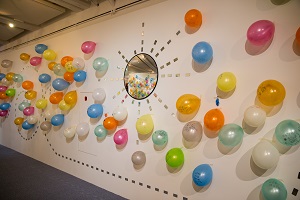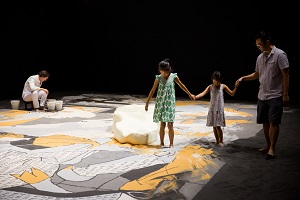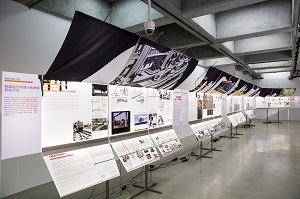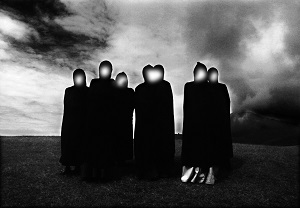Highlights of TFAM exhibitions in summer vacation
By Yali Chen While some children spend their summer vacations at sleep-away or day camps, many hang around their homes wasting the hours in front of the TV or glued to their tablets and smartphones. With summer vacation rapidly approaching, many parents are starting to wonder how they can entertain their children while teaching them a thing or two when school is out. Fortunately, the Taipei Fine Arts Museum (TFAM) is home to many exhibitions and other educational retreats in summer vacation. Now it's a great time to expand your kids' minds with these family-friendly museum exhibits in Taipei. This summer, four special exhibitions at the Taipei-based TFAM include "I Want to Dream," "Lee Mingwei and His Relations: The Art of Participation," "Post-Oil City: The History of the City's Future," and "Make Sense." Those with children will be happy to know that the TFAM is now holding a special exhibition, titled "I Want to Dream," because its target audiences are children ages 5 to 15. During the 8-month event, a total of 22 artists from Taiwan and overseas are showcasing their artworks in a wide variety of media, such as painting, sculpture, video, installation, and interactive sound art. They include Wang Chien-hao, Wang Te-yu, Pak Sheung-chuen, Lee Tzu-hsun, Bei Lynn, Marcos Lutyens, Tsui Kuang-yu, Hans Arp, Tao Chiang, Tsai Hai-ru, Pong Pong-ho, Even Wu, Jam Wu, Agi Chen, Yang Hsueh-hua, Huang Chun-lin, Alice Wang, Chu Yuan-nan, Alston Lee, Pii Chang, and Giant Kung. The theme of this special exhibition is divided into four parts: "Shall We Dance?" "Hello, Artist!" "Go Ahead and Go Wild!" and "Fantasia of Life." The first part "Shall We Dance?" spans a wide range of art forms, such as paintings, readymade sculptures, mechanical kinetic sculptures, interactive sound installations, space installations, participatory projects, on-site murals, and video documentaries. The second "Hello, Artist!" is a temporary on-site studio, where artists from different disciplines take turns showcasing their artworks and making art in the Taipei-based museum on an unscheduled basis. In the third section "Go Ahead and Go Wild!" artists work with the museum staff to conduct "creative experiments," and visitors of all ages are welcome to join the creative process. The final section "Fantasia of Life" functions as a reading area with a total of 80 story books and picture books about dream, aspirations, adventure, courage, exploration, and self-realization. Children can bounce on Wang Te-yu's colorful purple airbags which fill up entire rooms. In fact, Wang's inspiration for his creation involves the guts and innards of aliens from horror movies. Tsai Hai-ru, a mother who has created her artwork with lots of mother-child imagery, sets up a wall of colorful balloons that viewers can write down their aspirations. Between May and September this year, the Taipei-based TFAM and the Mori Art Museum in Tokyo is holding their joint exhibition in Taipei – "Lee Mingwei and His Relations: The Art of Participation." Since the late 1990s, Lee Mingwei, a Taiwan-born artist living in New York, has not only worked on numerous art projects that involve the participation of an audience in some form or another, but also participated in countless international exhibitions. For him, "Lee Mingwei and His Relations" is the first major exhibition enabling visitors to gain a better understanding of the most important artworks during his 20-year artistic career. A number of Lee's works will come to completion through a lot of audience participation. All visitors are encouraged to join as much as possible, thereby exploring with Lee in the meaning of "connections." At the same time, artworks and quotations by ten artists, religious leaders and thinkers – Hakuin, D. T. Suzuki, Yves Klein, John Cage, Allan Kaprow, and Rirkrit Tiravanija, as well as Wu Mali, Michael Lin, Jun Yang, and Wu Chien-ying – will provide visitors some clues to understand the historical and cultural context of Lee's creations. Can cities around the world function without oil in the future and what would such cities look like? The negative side effects of fossil fuel use are becoming increasingly apparent and costly. The exhibition "Post-Oil City: The History of the City's Future" presents a series of solutions for the post-oil cities envisioned by a group of architects, planners, designers and engineers from 10 different countries. Apart from innovative projects in Asia, Africa, and America, the exhibition will also address several urgent urban questions: How will the transition from fossil fuels to renewable energy affect the process of city planning? How will the use of renewable energies affect urban metabolism and the politics of sustainability and mobility? Meanwhile, "Post-Oil City" contrasts 11 current projects in the field of sustainable urban planning with 9 from the past in an effort to show that many of today's developments have their roots in the urban utopias of mid-20th-century modernism. Urban planners are now returning to these concepts and adapting them to the challenges posed by climate change, limited fossil fuels, economic recession, and global systemic crisis. Urban planning provides a laboratory for social and ecological changes. Some experiments discussed in the exhibition are Masdar City (Abu Dhabi), Xeritown (Dubai), and the N.E.S.T. project (Ethiopia). London-based architect Raoul Bunschoten and his cutting-edge urban design team at CHORA are currently pursuing several interactive projects giving communities on both sides of the Taiwan Strait the chance to experience new forms of urban design and energy production. Most of the projects are accompanied by computer animations and video clips. Although different in method and scope, the projects presented in the exhibition all have something in common: they exemplify the combination of reason, innovation, and flexibility that people will need to make their cities and the planet sustainable for the future. With very limited domestic energy resources, Taiwan relies on imports for near 98 percent of its energy consumption. It is a curious paradox that without fossil fuels the island has a comprehensive petrochemical industry. But the effects of the petrochemical industry on local people's life can no longer be ignored. The exhibition "Make Sense" presents a wide range of paintings, photography, installations, video documentaries, and performances created by eighteen individuals and groups, including local artists Chang Chao-tang, Chang Ting-tong, Chao Jui-kuang, Lee Min-chun & Cheng An-chi, Fan Hsiao-lan, Hsiao Pei-i, Huang Hsin-yao, Huang Wei-min, Ginger Wang & Lee Ming-ying, Lin Ho-ho, Lin Shu-kai, Su Yu-hsien, Tsai Meng-chang, Tseng Sheng-hui, Tu Pei-shih, Yang Che-yi, Yuan Goang-ming, and Zheng Chong-xiao. Tsai Meng-chang's painting "Factory," for example, depicts the refinery chimneys and distillation columns in the petrochemical industrial city of Kaohsiung. The issue of nuclear waste storage and energy consumption efficiency has become a hot topic in Taiwan. The exhibition also explores how people can coexist and utilize nuclear energy. In some cases, Chang Chao-tang's creation "Taiwan – And then Nuclear Disaster…" conveys the artist's unease with nuclear disasters. Tu Pei-shih's work "11 Steps Towards Happiness" borrows from the Canada Emergency Measures Organization's "11 Steps to Survival (in a Nuclear Fallout)," using humorous and exaggerated images to highlight the huge gap between daily life and true disasters.
STAFF WRITER "I Want to Dream"
"I Want to Dream"
Date: June 13, 2015 through Feb. 21, 2016
Venue: Children's Art Education Center
Opening hours: 9:30am – 5:30pm Tuesdays to Sundays, 9:30am – 8:30pm Saturdays "Lee Mingwei and His Relations: The Art of Participation"
"Lee Mingwei and His Relations: The Art of Participation"
Date: May 30, 2015 through Sep. 6, 2015
Venue: Gallery 1A and 1B at the TFAM
Opening hours: 9:30am – 5:30pm Tuesdays to Sundays, 9:30am – 8:30pm Saturdays "Post-Oil City: The History of the City's Future"
"Post-Oil City: The History of the City's Future"
Date: May 16, 2015 through Aug. 16, 2015
Venue: Gallery 3C at the TFAM
Opening hours: 9:30am – 5:30pm Tuesdays to Sundays, 9:30am – 8:30pm Saturdays "Make Sense"
"Make Sense"
Date: May 23, 2015 through Aug. 30, 2015
Venue: Gallery 3A and 3B at the TFAM
Opening hours: 9:30am – 5:30pm Tuesdays to Sundays, 9:30am – 8:30pm Saturdays

![Taiwan.gov.tw [ open a new window]](/images/egov.png)
